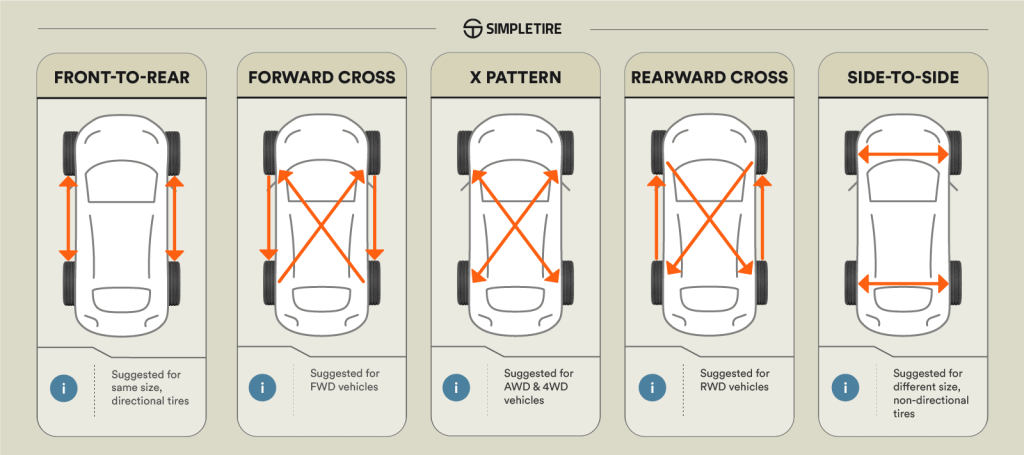Tires are your car’s only contact with the road—a small but mighty connection that handles everything from blazing highways to rain-slicked corners. Keeping them in top shape isn’t just about grip; it’s about safety, fuel efficiency, and saving money by squeezing every mile out of your investment.
One of the most overlooked but essential maintenance tasks? Tire rotation. Done right and on time, it can dramatically extend tire life and keep your ride balanced and smooth.
Why Rotate Your Tires?

Tire rotation means moving your tires from one position on the car to another, usually front to back and vice versa, sometimes swapping sides too. This helps even out the wear caused by:
- Different loads: Front tires often bear more weight and handle steering.
- Driving style: Front-wheel drive cars wear front tires faster; rear-wheel drives affect rear tires more.
- Road conditions: Imperfections cause uneven tread wear patterns.
- Brake force: Front brakes generally do more work, wearing down those tires sooner.
By rotating tires regularly, you avoid uneven wear, which can cause poor handling, reduced traction, and premature tire replacement.
When Should You Rotate Your Tires?
Most manufacturers recommend rotating your tires every 5,000 to 8,000 miles—roughly every other oil change. But always check your owner’s manual for the specific interval for your vehicle.
If you notice signs like:
- Uneven tread wear (bald spots or scalloping)
- Vibrations or pulling to one side
- Decreased fuel efficiency
—it might be time to rotate your tires even sooner.
How to Rotate Tires: Step-by-Step Guide
Tools You’ll Need:
- Jack and jack stands (or a hydraulic lift if you have one)
- Lug wrench or impact wrench
- Torque wrench (for proper lug nut tightening)
- Wheel chocks
Rotation Patterns

The rotation pattern depends on your drivetrain and whether your tires are directional (designed to spin in only one direction) or non-directional.
- Front-Wheel Drive (Most Common)
- Move front tires straight back to the rear.
- Move rear tires diagonally forward to the opposite front position.
- Rear-Wheel or 4WD/AWD Vehicles
- Move rear tires straight to the front.
- Move front tires diagonally back to the opposite rear position.
- Directional Tires
- Tires designed to rotate in one direction should only be swapped front-to-back on the same side (no crossing).
Step-by-Step Process:
- Prepare Your Workspace: Park on a level surface, engage parking brake, and place wheel chocks behind the wheels remaining on the ground.
- Loosen Lug Nuts: Slightly loosen lug nuts on all wheels while the car is on the ground (don’t remove yet).
- Lift the Car: Use the jack to raise the car and secure it on jack stands.
- Remove Wheels: Completely remove lug nuts and wheels.
- Swap Tires According to Pattern: Follow the appropriate rotation pattern and place the tires in their new positions.
- Reinstall Wheels: Put lug nuts back on by hand to start.
- Lower the Car: Carefully lower the car back to the ground.
- Torque Lug Nuts: Use a torque wrench to tighten lug nuts to the manufacturer’s specifications in a star pattern to ensure even pressure.
Pro Tips for Tire Rotation

- Inspect Tires: Check tread depth, look for damage, and clean any debris while rotating.
- Balance and Alignment: If you notice vibration after rotation, have your tires balanced or alignment checked.
- Record Rotation Dates: Keep a maintenance log so you don’t forget.
- Replace Worn Tires: Rotation won’t fix tires worn beyond safe tread depth—replace them promptly.
Final Thought: Rotate to Elevate Your Ride
Tire rotation may sound like a simple swap, but it’s a small ritual with a big payoff—better traction, smoother handling, and longer tire life. It’s one of the smartest, most budget-friendly ways to keep your car running safely and efficiently.
Treat your tires right, and they’ll repay you with every mile of confident grip on the road ahead.









